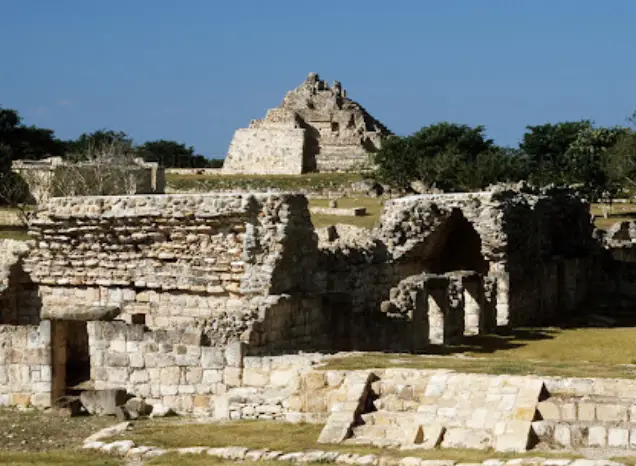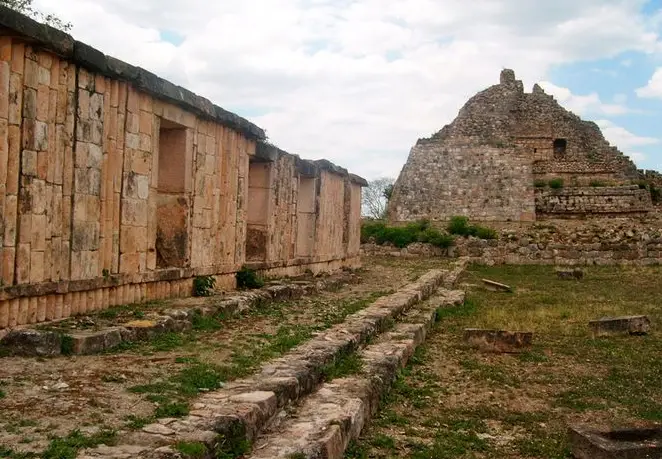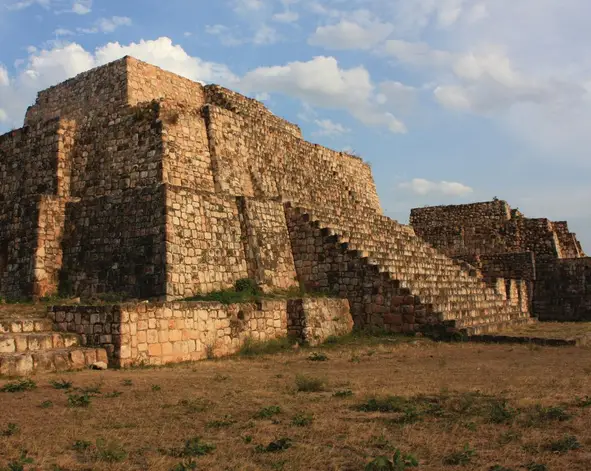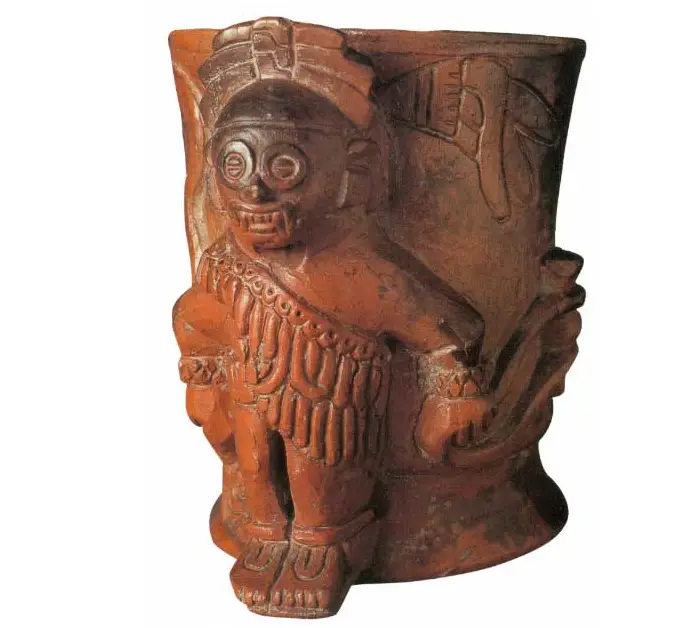Podcast: Play in new window | Download
Subscribe: Apple Podcasts | RSS
 In the dusty royal archives in Madrid there is an obscure 16th Century account written by a Spanish monk named Antonio de Ciudad Real who made note of an abandoned and ruined city located somewhere in the northwestern Yucatán proximate to the Puuc Mountains. Brother Antonio described the large buildings covered in the scrub jungle and paid specific attention to a mysterious labyrinth – a maze made of stone – found in the ruins. With the interpretation of locals who were guiding him throughout the area, the monk wrote this about the maze-like building: Quote. “This was the place where they tossed those who had committed great offenses so that there they may die.” End quote. The site would receive very little attention for nearly three more centuries until the arrival of the famous duo of Stephens and Catherwood in 1842. They explored the site, made some sketches and did a bit of digging, but soon moved on from these enigmatic ruins. Stephens and Catherwood also made note of the mysterious maze still standing at this yet-unnamed place. The little-known lost city got its formal name of “Oxkintok” after archaeologists literally found it set in stone on a monument at this place. The name glyph comprised three parts “osh” meaning “three,” “kin,” meaning “day” or “sun,” and “tok” which has been interpreted to mean “flint” or “hard stone.” So, loosely, the ancient Maya name for this place was “Flint of the Three Suns.”
In the dusty royal archives in Madrid there is an obscure 16th Century account written by a Spanish monk named Antonio de Ciudad Real who made note of an abandoned and ruined city located somewhere in the northwestern Yucatán proximate to the Puuc Mountains. Brother Antonio described the large buildings covered in the scrub jungle and paid specific attention to a mysterious labyrinth – a maze made of stone – found in the ruins. With the interpretation of locals who were guiding him throughout the area, the monk wrote this about the maze-like building: Quote. “This was the place where they tossed those who had committed great offenses so that there they may die.” End quote. The site would receive very little attention for nearly three more centuries until the arrival of the famous duo of Stephens and Catherwood in 1842. They explored the site, made some sketches and did a bit of digging, but soon moved on from these enigmatic ruins. Stephens and Catherwood also made note of the mysterious maze still standing at this yet-unnamed place. The little-known lost city got its formal name of “Oxkintok” after archaeologists literally found it set in stone on a monument at this place. The name glyph comprised three parts “osh” meaning “three,” “kin,” meaning “day” or “sun,” and “tok” which has been interpreted to mean “flint” or “hard stone.” So, loosely, the ancient Maya name for this place was “Flint of the Three Suns.”
The site has yielded archaeological evidence spanning from the Late Preclassic through the Late Postclassic periods of Maya prehistory. However, Oxkintok emerged as a prominent center between the Early Classic and Terminal Classic periods, particularly during what Mexican archaeologist Carmen Varela identifies as the “Middle Classic” era. This means that the city’s heyday lasted between about 250 AD and sometime in the late 1400s. Notably, Oxkintok boasts one of the earliest Long Count dates, recorded in 475 AD on the lintel of Structure 6 within the “Ah Canul” group. The latest dated monument at the site reads 859 AD. Excavations at Oxkintok have uncovered approximately 70,000 pot sherds and 38 complete vessels, forming the basis for its chronology, primarily revolving around pottery types indicative of different periods in Maya culture. However, ongoing discussions among archaeologists persist regarding the interpretation of these ceramics, prompting the consideration of other factors such as architecture and iconography in the chronological framework. Like all other great cities in the Maya world, this city experienced a form of abandonment in the 10th century, although there was still a population living there for hundreds of years after what historians call the Classic Maya Collapse. By the time the Spanish monk Antonio de Ciudad Real arrived at Oxkintok in the 1500s, the city had been completely void of people for nearly a hundred years and was thoroughly overtaken by nature.
 So, what does Oxkintok look like? The core area of the site comprises four main groups, accessed from the north. A well-preserved entry arch greets visitors to the east, leading to a cluster of low structures. Further southeast lies the renowned Labyrinth or Tzat Tun Tzat, initially mistaken for a cave due to its earth and vegetation cover. The building features intricate passages possibly used for ritual purposes. It is now closed to the public and is serving as a storage area, constituting the main focus of the Satunsat Group.
So, what does Oxkintok look like? The core area of the site comprises four main groups, accessed from the north. A well-preserved entry arch greets visitors to the east, leading to a cluster of low structures. Further southeast lies the renowned Labyrinth or Tzat Tun Tzat, initially mistaken for a cave due to its earth and vegetation cover. The building features intricate passages possibly used for ritual purposes. It is now closed to the public and is serving as a storage area, constituting the main focus of the Satunsat Group.
Adjacent to the Labyrinth stands a small structure boasting exquisite Puuc-style decorative stonework, believed to be the site’s oldest building. Continuing southeast, the main pyramid overlooks the South Plaza, crowned by a temple structure and adorned with a sculpture bearing a Kin sign, offering panoramic views of the site from its summit.
On the northwest side of the South Plaza lies the Dzib Group, encompassing several structures including the ball court. Towards the east, beside the pyramid, sits a sprawling multi-roomed palace atop a raised platform, with a grand temple facing the plaza’s eastern side, revealing a buried cache upon recent excavation, forming the Ah Canul Group. The Ah Canul Group, with its three pyramids, is thought to be the seat of power of the city, where the priests and members of the noble classes gathered and lived. An interesting feature at Oxkintok is a series of underground tunnels radiating out from the more elite Ah Canul Group to the other parts of the city. It is a complete mystery why these tunnels were constructed and what they were used for.
Further eastward lies a courtyard-centric complex, featuring unique sculpted statues before a columned palace, while the north side hosts a palace structure with a chultun or cistern nearby. Transitioning through this area leads to a spacious enclosed plaza, showcasing a well-preserved arch in its eastern wall, flanked by a palace structure along the north side.
*To the south of the South Plaza stands the May Group, featuring a “C”-shaped courtyard with a central pyramidal structure bordered by low platforms housing smaller structures. Throughout the site, numerous other structures in varying states of preservation offer glimpses into Oxkintok’s rich architectural legacy.
 The architecture at Oxkintok merits a separate and more in-depth discussion. It presents a fascinating amalgamation of Early, Late, and Terminal Classic Maya styles and includes influences from outside the Maya area. While some structures feature slab-vaulted masonry indicative of the Early and early Late Classic periods, others showcase veneer masonry introduced towards the end of the Late Classic and elaborated upon during the Terminal Classic era. Notably, Oxkintok serves as a prime example of the transition from traditional Classic Period architecture to what academics call “Puuc Veneer masonry.” Additionally, the site exhibits “talud-tablero” architecture, commonly associated with central Mexican sites like Teotihuacan and Monte Albán, indicating diverse architectural influences across different regions and time periods.
The architecture at Oxkintok merits a separate and more in-depth discussion. It presents a fascinating amalgamation of Early, Late, and Terminal Classic Maya styles and includes influences from outside the Maya area. While some structures feature slab-vaulted masonry indicative of the Early and early Late Classic periods, others showcase veneer masonry introduced towards the end of the Late Classic and elaborated upon during the Terminal Classic era. Notably, Oxkintok serves as a prime example of the transition from traditional Classic Period architecture to what academics call “Puuc Veneer masonry.” Additionally, the site exhibits “talud-tablero” architecture, commonly associated with central Mexican sites like Teotihuacan and Monte Albán, indicating diverse architectural influences across different regions and time periods.
The architecture at Oxkintok is typically analyzed by dividing it into four main groups: May, Satunsat, Ah Canul and Dzib, which constitute the urban center and predominantly feature monumental structures. Although these groups are well-defined by the site’s excavation teams, this unique lost city holds potential for further exploration beyond these clusters, with a heavy emphasis on excavating monumental architecture such as temples, palaces, and multi-room structures. Like so many Maya sites only a small fraction of the city has been excavated and explored, giving modern people only a glimpse into Oxkintok’s former glory. To trace the architectural evolution at the site, researchers have compiled data indicating significant changes between different periods, transitioning from irregular to geometric designs adorned with elaborate stucco art and stone decorations, while retaining consistent elements like domes and arches for entryways and open spaces. Notably, while the Ah-Canul group exhibits a concentration of Proto Puuc architecture, the May group displays Early Oxkintok influences later modified during the Proto Puuc phase. Yes, this is all very technical, but it serves to illustrate a dynamic architectural history at the city with overlapping phases and influences.
A standout feature of Oxkintok is the building called Satunsat, whose name comes from three Maya words, “tzat,” “tun” and “tzat.” This unusual structure is characterized by the enigmatic labyrinth which has intrigued and mystified explorers and researchers alike since the site’s rediscovery. This single-building stone maze complex has sparked intrigue regarding its purpose, with recent discoveries suggesting possible solar alignments in its ventilation shafts. Although the exact function of Satunsat remains uncertain, evidence suggests its construction during the early Oxkintok phase. As mentioned earlier, this bizarre building is currently closed to tourists as Mexico’s National Institute of Anthropology and History debates how best to preserve it and whether it would be a good idea to open it to the general public at all.
 Additionally, Oxkintok is renowned for its anthropomorphic columns, sculpted during the Late to Terminal Classic periods. These human figure columns are akin to the caryatids of ancient Greece and depict elites, warriors, and deities, potentially serving as precursors to similar sculptures at later Mayan sites. Despite challenges posed by looting, Oxkintok’s tombs offer valuable insights into Mayan burial practices, predominantly featuring male burials of high status, accompanied by offerings like shell jewelry, jade artifacts, and tripod ceramics, underscoring the site’s cultural significance across different historical periods.
Additionally, Oxkintok is renowned for its anthropomorphic columns, sculpted during the Late to Terminal Classic periods. These human figure columns are akin to the caryatids of ancient Greece and depict elites, warriors, and deities, potentially serving as precursors to similar sculptures at later Mayan sites. Despite challenges posed by looting, Oxkintok’s tombs offer valuable insights into Mayan burial practices, predominantly featuring male burials of high status, accompanied by offerings like shell jewelry, jade artifacts, and tripod ceramics, underscoring the site’s cultural significance across different historical periods.
Fortunate for researchers, Oxkintok is a city full of glyphs and descriptive artwork which aid in understanding the history of this place and what life was like for the ancient Maya here many centuries ago. The primary source of information regarding the inscriptions at Oxkintok derives from the Dzib architectural group, encompassing the ball court, two staircases, and 18 stelae featuring various forms of iconography. While the stelae are largely illegible or uninterpretable due to significant erosion and decay, their placement in the Late Classic period is evident through other distinguishing characteristics. There are two staircases mentioned are completely covered in writing. The precise meaning of the first staircase remains elusive and has only been partially deciphered. This first staircase is presumed to share similarities with the second one, which notably references a ruling family or dynasty by the name of “Walas,” suggesting a dedication to this noble family. The Walas family is also mentioned in inscriptions on other monuments and had a unique relationship with the sun god that archaeologists do not completely understand. Additionally, an enigmatic calendar wheel, possibly associated with the ball court ring – given their same starting dates – adds further intrigue. Inscribed with the presumed construction dates of 713 to 714 AD, the ball court ring provides valuable chronological insight. It’s plausible that additional inscriptions or iconography may have been lost over time due to the rapid weathering of the karstic limestone and sandstone materials used in construction. Also, the city has been subject to looting over time. A conspicuous “hiatus” in writing coincided with a surge in architectural activity at Oxkintok between 550 and 650 AD, a phenomenon yet to be fully understood. Another thing missing in the written record throughout the city are any references to wars, captives, or conflicts with neighboring cities. There are no records of tribute paid to or received from other Maya kingdoms. This lack of evidence of violence along with the absence of fortifications at Oxkintok leads archaeologists to believe that the people of this city enjoyed a relatively peaceful existence. With more excavation and restoration efforts at the site, archaeologists are certain to find more artifacts or structures containing ample glyphs and iconography that will help them understand this place better and will fill in the blanks of its history. The body of knowledge of Maya history changes by the week and it’s only a matter of time before the full story of Oxkintok will be known.
REFERENCES
INAH Website
